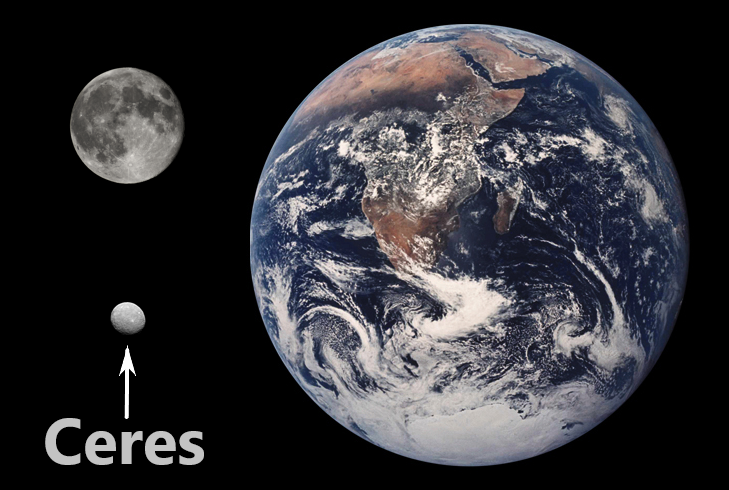Appointment with the sky Spring is here: how to enjoy its skies
Chronicles of the cosmos The core of the Milky Way seen like never before
Enigmatic Ceres is a small world very different from its myriad neighbors in the asteroid belt.
A new study explains why.
Great among the asteroids
Ceres is the largest object in the asteroid belt that lies between the orbits of Mars and Jupiter.
Its diameter of 945 kilometers caused it to be considered a true planet when it was discovered on January 1, 1801 by Giuseppe Piazzi.
However, similar to what happened to Pluto a few years ago, Ceres was removed from the league of planets when, in the 1850s, other similar objects were discovered among its neighbors, such as Pallas, Vesta or Juno.
Currently, like Pluto, Ceres has been embedded in the group of dwarf planets.
Compared sizes of Ceres, Earth and Moon. Public domain
With a mass that reaches a third of that of the entire asteroid belt, Ceres seems the standard-bearer of such bodies and one might think that it is their maximum representative.
Sharing an orbit with its neighbors, it was long assumed that the entire belt (Ceres included)
could have formed simultaneously in the protosolar nebula
and that Ceres and all the asteroids in the belt would be similar.
water and ammonia
NASA's Dawn spacecraft, which spent several years studying the dwarf planet, discovered that it contains a rocky core surrounded by a shell of ice.
Above this layer, the surface contains a mixture of
various carbonates, clay, and water ice
.
Ceres' surface composition and high reflectivity make it similar to C-type asteroids (carbonaceous chondrites, in astronomical parlance).
However, upon closer examination, Ceres reveals that it has major differences from its neighbors.
Most C-type asteroids don't have as much water and don't have as much clay.
In addition, the surface of Ceres has a
high abundance of ammonia
, a compound that is rare in asteroids.
Ammonia is not common in the inner regions of the solar system, since solar radiation evaporated it at the initial stage of its formation, but it
is abundant in the outer regions
, where it has been able to survive together with other volatile chemical compounds.
uncertain origin
More than its asteroid neighbors, Ceres resembles distant Pluto, Charon, Eris, and other Kuiper belt bodies found in the outermost regions of the solar system.
How to explain this anomaly?
Perhaps Ceres formed strangely and independently of the rest of the asteroids.
Or maybe it formed along with them, but a lot of water and ammonia came later from the outer region of the solar system to settle on the dwarf planet.
They
are hypotheses that do not seem very plausible
.
A new study, led by Rafael Ribeiro de Sousa, from the University of Sao Paulo, now proposes
an explanation for the origin of Ceres that seems much more plausible
: Ceres could have formed beyond the orbits of the giant planets and could have migrated, after , to the asteroid belt where it is now.
great migrations
The solar system was formed from a large disk made up of small "planetesimal" rocks that
were added to each other to form progressively larger bodies
.
The giant planets trapped large amounts of gas from the protosolar nebula and, according to currently accepted models, formed closer together and closer to the Sun than their modern locations show.
The migration of the giant planets from their places of formation to their current positions caused great disturbances in the other smaller bodies of the solar system, in particular in those of the Kuiper belt.
Some objects were thrown out of the planetary system,
others were trapped as satellites of the giant planets
(such as Triton by Neptune) and others, finally, were directed towards the interior regions of the solar system.
The latter is what could have happened to Ceres.
time capsules
Thus, the most plausible explanation for the origin of Ceres is that its formation took place in the icy edges of the solar system, where ammonia and other volatile compounds abound.
Once formed, the dwarf planet was
disturbed by the migrations of the giant planets
and eventually moved to its current position in the asteroid belt.
Asteroids, comets and, generally speaking, all the small bodies that formed in the early stages of the solar system, and have remained relatively unchanged since then, are like time capsules that contain key information about the characteristics of the nebula. protosolar
If it really has come from the far reaches of the Kuiper belt, Ceres may offer us
valuable clues to the origins of our planetary system
.
The article by Ribeiro de Sousa and collaborators, titled Dynamical origin of the Dwarf Planet Ceres, has been recently published in the Icarus magazine.
The manuscript can be consulted at this link.
Rafael Bachiller
is director of the National Astronomical Observatory (National Geographic Institute) and academic of the Royal Academy of Doctors of Spain.
Conforms to The Trust Project criteria
Know more
AstronomyZodiac light: what it is and how to observe it
Spring 2022 Spring is here: how to enjoy its skies
AstronomyThe biggest star ever seen
See links of interest
War Ukraine Russia
last minute transportation strike
Last News
Time change 2022
Oscars movies where to watch
Oscar nominees
best colleges
It is written to have or to see
Topics
Work calendar 2022
Ibiza - Real Sociedad B
Eibar - Lugo
Sporting Gijon - FC Cartagena
Spain - Albania, live
Real Oviedo - Fuenlabrada

